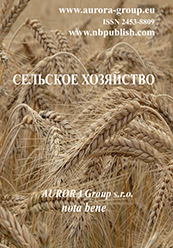Horticulture
Reference:
Mukhametova, S.V., Kurnenkova, I.P., Ignatova, O.I. (2025). Vital state of plantings along Karl Liebknecht Street in Yoshkar-Ola. Agriculture, 1, 1Ц13. https://doi.org/10.7256/2453-8809.2025.1.73284
Abstract:
The street greening is a means of improving the urban environment and is of great ecological importance. At the same time, anthropogenic stress leads to a decrease in the living condition of plantings and their resistance to adverse factors of the urban environment, including pathogens and pests. The presented study provides the vital condition analysis of woody plants growing along Karl Liebknecht Street in Yoshkar-Ola (Mari El Republic) in 2024. The object of the study was plantings on landscaping strips along the roadway. The sanitary condition was assessed according to the 5-point scale given in the Rules of Sanitary Safety in Forests (2020). The main part of the plants (87%) belongs to the second category of sanitary condition. 28 dead specimens (3%) were found, they must be removed and replaced with new plants. In general, the living condition of the studied plantings at this facility is assessed as weakened, which indicates a good environmental situation on K. Liebknecht Street. The most frequent damage to tree trunks are gnarled hollows and deadwood, various species of aphids are most widespread on the leaf apparatus. A negative fact is the forced pruning of birch trees located under power lines because it negatively affects the vital condition of plants and reduces decorative effect. Rowan plantations are severely weakened, and the condition of maples, apple trees, and lime trees is slightly better. The shrubs on the surveyed street are generally in better condition than the trees. It is necessary to carry out agrotechnical measures for the care of plantings to increase their viability. Studies of plantings condition of K. Liebknecht Street were conducted for the first time, in the future similar studies will be carried out on other streets of the city.
Keywords:
landscaping strips, plant damage, diseases and pests, categories of condition, sanitary condition, woody plants, city streets, urban plantings, green spaces, tree pruning
Land and soil
Reference:
Nureev, N.B. (2025). Morphological features of soils in post-pyrogenic forest plantations. Agriculture, 1, 14Ц23. https://doi.org/10.7256/2453-8809.2025.1.73469
Abstract:
The subject of the study is post-pyrogenic pine forest plantations and their effect on the external signs of soils. The influence of the forest fires of 2021 on the morphological features and structure of the soil cover on sandy soils of the Republic of Mari El was studied. The results showed a significant change in the composition and condition of vegetation in the studied areas, as well as the upper organogenic and organomineral horizons, both in composition and thickness. Grass-roots fires caused the burning of the bark of pine plantations to a height of 1-2 m, the destruction of the grass and shrub cover. As a result of forest fires, a peculiar pyrogenic horizon Orig is formed, characterized by ash residues of plant litter with a small variability in power in all the studied areas. The sinterability of the mineral particles of the upper horizons has not been detected.†The structure of the soil profile and the changes that occurred in the post-fire period were studied by the method of laying full-profile soil sections with the identification of diagnostic horizons and features. The classification, diagnosis and description of soils were carried out according to the "Classification and diagnosis of soils of Russia" with amendments and additions (2008, 2022) and the "Field soil Determinant of Russia" (2008). The main conclusions of the work explain the formation of pyrogenic forest litter (Orig) in the form of ash residues with a thickness of about 3 cm, the absence of signs pyrogenicity in the upper mineral horizons and unusual color changes. The formation of an underdeveloped protohumus horizon with signs of gilding, manifested in an uneven distribution of silica powder along the horizon, has been revealed. A feature of all the studied soils is a light granulometric composition throughout the profile and poor soil-forming rock, represented by ancient alluvial sands. The author pays special attention to the description of soils using the modern soil classification (2004, 2022), which uses a more up-to-date indication of soil horizons and features. For a more detailed analysis of the impact of fires on the power of various horizons, a statistical analysis of the data was carried out, which clearly shows a decrease in the variability of the power of the upper horizons.
Keywords:
forest litter, Republic of Mari El, post-pyrogenic plantings, forest ecosystems, soil diagnostics, soil-forming rock, soils, soil section, morphological features of soils, forest fires
Agricultural complex
Reference:
Svetskiy, A.V. (2025). Artificial Intelligence in the Agro-Industrial Complex: Issues of Legal Regulation and Prospects for Use. Agriculture, 1, 24Ц38. https://doi.org/10.7256/2453-8809.2025.1.73722
Abstract:
Agriculture is the foundation of the sustainability of any economy. It plays a key role in long-term economic growth and structural transformations. In the process of achieving the goal of maximizing yield, the agro-industrial complex faces numerous challenges, including inappropriate soil treatment, disease and pest infestations, low productivity, and gaps in knowledge between farmers and technologies. The main concept of applying AI in agriculture is based on its flexibility, high productivity, accuracy, and economic efficiency. Currently, there are several legal regulatory issues regarding AI systems in agriculture that require clarification from lawmakers, as existing legal norms, both at the international and national levels, are not sufficiently detailed and do not cover all aspects of AI implementation in agriculture. Today, the AI market in agriculture is most developed in three promising areas: machine learning, computer vision, and predictive analytics. Various countries are developing strategies for agricultural practices using artificial intelligence, which should mark the beginning of the development of legal regulation in this field at the international level. Both state and international levels should actively support innovations in AI by creating favorable conditions for the development and implementation of new technologies, as well as ensuring their safety and transparency. Artificial intelligence has high potential to transform the agro-industrial complex, allowing for optimized production, increased yields, reduced resource costs, and minimized environmental damage. However, to realize this potential, several technical, legal, and ethical issues that exist in the regulation of information technologies and artificial intelligence in particular must be addressed.
Keywords:
agricultural data, weeds, agro-industrial crops, machine learning, international standards, national legislation, ELR, agriculture, artificial intelligence, agro-industrial complex
Land and soil
Reference:
Savin, I. (2025). Definition of soil as a separate natural body. Agriculture, 1, 39Ц52. https://doi.org/10.7256/2453-8809.2025.1.73661
Abstract:
Despite the more than one hundred years history of soil science, its object is still not clearly and unambiguously defined. Different definitions of soil can be found in the scientific literature and manuals. Uncertainty of this term, even in the scientific environment, leads to underestimation of practical significance of soil science as a science and to misunderstanding of the term "soil" both by related specialists and the general population. The accumulated factual data and the whole experience of soil science allow at this stage to make an attempt to clarify its basic concepts, including the object of research. The subject of research is the soil science and clarification of its definition in order to specify the concept of "soil" as an isolated natural body. Analysis of existing definitions of soil served as a basis for formulating a new definition of soil as an isolated natural body. An alternative view of soil as an isolated natural body is presented. It is proposed to consider soil as a natural body formed as a result of transformation of wastes of organic life on the planet and related processes under the influence of external conditions. From this point of view many properties and functions of soil should be reinterpreted. The proposed definition allows us to position soil as an isolated natural body that is a link in the single global cycle of life on Earth: in the process of soil formation, waste products of plants, animals, microorganisms, and humans are transformed into soil, which in turn ensures the reproduction and existence of life by feeding and growing plants (soils fertility function) as the beginning of all major trophic chains on the planet.
Keywords:
soil mineralogical properties, soil organic matter, soil classification, soil genesys, soil properties, soil functions, bioinert body, soil science, chemical soil properties, soil evaluation
 This work is licensed under a Creative Commons Attribution-NonCommercial 4.0 International License.
This work is licensed under a Creative Commons Attribution-NonCommercial 4.0 International License.










 © 1998 Ц 2025 Nota Bene. Publishing Technologies. NB-Media Ltd.
© 1998 Ц 2025 Nota Bene. Publishing Technologies. NB-Media Ltd.




